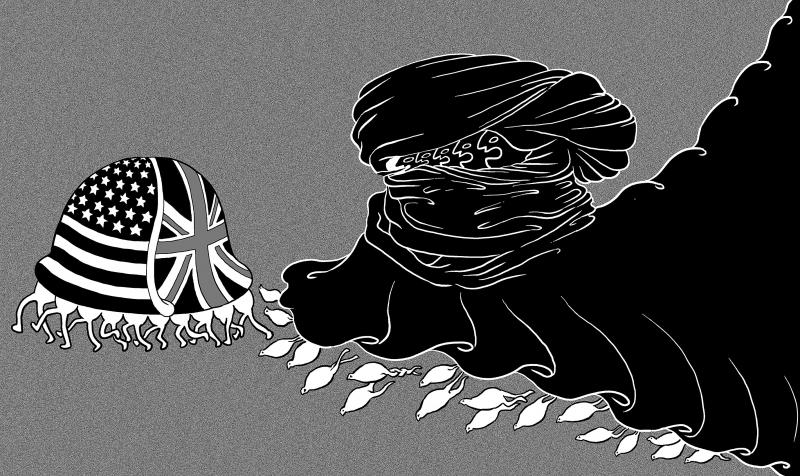Simon Tisdall

Military retreats from Afghanistan are problematic, as the British (1842) and the Red Army (1989) discovered to their cost. The cliffs of the Khyber Pass feature many memorials and plaques to departing or defeated foreign forces.
This year’s Afghan withdrawal is less fraught — the US is not yet retreating under fire — but the march to the exit has nonetheless turned into an undignified sprint.
Most Americans will welcome this accelerated end to an unpopular war, yet it spells catastrophe for Afghans who pinned their hopes and their nation’s future on Western support in fighting the Taliban and Islamist terrorism, and who believed the nation-building promises made by former US president George W. Bush and others.
Fighting is spreading like a bushfire from district to district. There is no peace deal in place, no power-sharing, no intra-Afghan ceasefire, and growing fear of nationwide conflagration — and yet still the Americans are leaving.
Two questions are unavoidable: After expending so much blood and treasure, what of lasting import was achieved? And what on earth will happen next?
When US President Joe Biden set a withdrawal deadline of Sept. 11, exactly 20 years after the al-Qaeda attacks that triggered the US’ intervention, the Pentagon decided to get out as soon as possible. Britain and other NATO allies are following suit. It is now expected all foreign forces, plus 17,000 mostly US contractors, will be gone by the middle of next month.
The outlook for the vast majority of Afghans who do not espouse extreme religious views and misogynistic feudal dogmas is simply terrifying.
Civilian casualties rose 29 percent in the January-to-March period, compared with last year.
Government figures recorded 4,375 terrorism-related deaths last month, up from 1,645 in April.
Among last month’s civilian victims were 50 schoolgirls from a Shia Hazara neighborhood in Kabul, deliberately targeted by Sunni militants. Aid workers, polio vaccinators and journalists, especially women, are also singled out. The terrorists’ agenda of hate is only too clear.
The Western-trained Afghan national army is struggling. Short of ammunition and supplies, 26 bases reportedly surrendered to the Taliban last month. An elite special forces commando unit was wiped out last week in Faryab Province. The army’s one big advantage — air power — is evaporating as foreign technical and logistical backup melts away.
Western politicians shield their eyes. They do not want to see, let alone discuss, what is about to happen. Entire provinces, such as Uruzgan, and provincial capitals such as Kandahar and Helmand’s Lashkar Gah, for which British troops fought, risk being overrun. Even Kabul itself might not be safe for long, according to gloomy CIA and military intelligence assessments.
Suggestions that the US would in future send combat aircraft and armed drones from neighboring nations to support Afghan ground forces were dismissed last week. General Frank McKenzie, head of US Central Command, said that even if Kabul were on the brink of falling, any post-withdrawal airstrikes would be limited to countering terror plots that threatened the US “homeland.”
Such unusual restraint reflects the Pentagon’s inability to find alternative bases within reasonable striking distance. Pakistan, which covertly backs the Taliban and fell out with the US in 2011, does not want US troops back. Kyrgyzstan and Uzbekistan, which previously hosted US troops and spies, are unlikely to do so again — for fear of offending Russia. Iran is out of the question.
The lack of a credible post-withdrawal security plan is matched by the absence of an agreed political path ahead. Talks in Doha between the Taliban and the government of Afghan President Ashraf Ghani have achieved little. Demands that Taliban leaders guarantee civil rights and girls’ education have not been met. US insistence that the Taliban refuse safe haven to al-Qaeda and the Afghan iteration of the Islamic State group has also been ignored. On the contrary, senior Afghan officials say, these Sunni groups are working together.
The Taliban’s aim?
Total victory.
The CIA’s fear that Afghanistan could again become a regional terror hub is shared by China and India. Beijing has offered investment and COVID-19 vaccines, seeking another link in its Belt and Road imperial master plan. China’s nightmare is that Afghan-based jihadists would join forces with persecuted Uighur Muslims in Xinjiang.
Ever greater fragmentation looms. Ethnic groups that comprised the Northern Alliance in the 1990s civil war oppose a fresh Taliban takeover. Ahmad Massoud, son of the Lion of Panjshir, Ahmad Shah Massoud, who was assassinated by the Taliban two days before the Sept. 11, 2001, attacks, says the mujahidin are ready to fight.
Escalating violence in Afghanistan could destabilize the region, add hunger and displacement to the existing problems of COVID-19, drought and climate change, create new refugee surges, destroy the quest for equal rights and justice for war crimes, and betray the sacrifices of Western and Afghan troops. Yet it is now a very real prospect.
Western politicians shield their eyes. They do not want to see, let alone discuss, what is about to happen. NATO last week pledged future security force training and funding, and said it would “continue to stand” with Afghanistan. Stand back, more like.
Catastrophe stalks the Afghan people.
NATO claims a “new chapter” is beginning. That is true, but it is a cause for fear, not pride. The US and its partners achieved little in terms of permanent progress, and even that meager legacy is now threatened.
Robert Gates, US secretary of defense under Bush and former US president Barack Obama, pleads: “The situation will doubtless worsen when US troops are gone... We cannot turn our backs.”
However, his is a lonely voice.
What to do?
I have been writing about Afghanistan for more than 30 years. I have reported from the nation, and personally witnessed its poverty and pain. I do not know the answer. Who does? But scurrying off home, regardless of the consequences, is certainly not it.
No comments:
Post a Comment